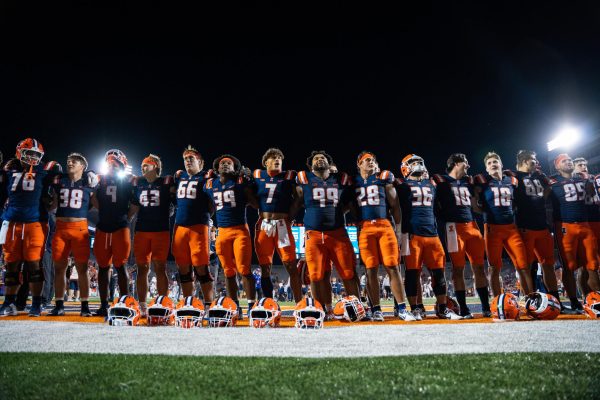Getting to know Campustown from day one
Aug 22, 2018
Every incoming freshman has visited the Main Quad at some point during their campus visits — it’s the big green area surrounded by a bunch of academic buildings. Well, it turns out using this as a reference point can help you get around campus quite easily, especially during move-in day.
Using the Main Quad as a way to give or even understand directions myself was what helped the most freshman year. It’s called the Main Quad for a reason, as it’s more or less considered the heart of campus, so most of what you’re going to be looking for is in any cardinal direction from there.
For example, the Bardeen Quad (also known as the Engineering Quad) is directly north of the Illini Union, just across Green Street. Ikenberry Commons is directly west from the McFarland Bell Tower on the South Quad, which is just south of Foellinger Auditorium. The Gies College of Business is right in the middle, between the bell tower and Ikenberry Commons.
Going off that, associating these buildings with restaurants, bars or even Greek houses can be helpful. If you’re a relative location type of person like me, it’s so much easier saying, “The Illini Union Bookstore is right by Altgeld Hall, so if you see an old bell tower just head in that direction” than saying “Go north down Wright Street after heading east on Armory.” In a pinch, just pull up Google Maps to see where you’re located if completely lost.
Of course, you’ll also probably need to learn how the bus system works here. There are definitely a lot of routes here on campus, almost to the point where it’s overwhelming. Try not to get hung up on trying to learn these routes as fast as possible; for me, it took about a month to finally be comfortable with most of the routes.
Get The Daily Illini in your inbox!
An easy thing to remember is to recognize what letter is at the end of the bus number — the letter stands for the cardinal direction of the route it’s taking. So if you see a 1S or 100S, then at least you know the general direction of that bus will be south.
Downloading one of the many bus apps is also extremely helpful. The more centrally-located stations will have bus clocks with times of upcoming buses, but having that on your phone screen is a godsend.
With these apps, you can time the departure and arrival times of buses to the minute, so heading all the way from Snyder Hall to the Siebel Center for your 9 a.m. CS 125: Introduction to Computer Science lecture isn’t much of a hassle. I personally use MyBusHelper, but that’s because I downloaded it on day one and have used it ever since. Ask any of my friends and they’ll have a different app that works better for them. It’s all about preference here.
It’s important to note that off-campus bus stops require students to show their i-card. So stops like Transit Plaza and Fourth and Gregory are game, but stops not near academic buildings or in clear residential areas are not. This can be kind of confusing, but you should really try to keep your i-card with you at all times.
If you’re trying to get around at night, especially during weekdays, buses are definitely handy. Buses stop running at 3 a.m. on weekdays and Sunday and at 5 a.m. on Fridays and Saturdays, so most of the time you’ll be good to go when trying to get back.
But sometimes waiting for the next bus is too much, or sometimes you just don’t even know where you are. If you find yourself a ways from your dorm and buses aren’t gonna cut it, definitely call SafeRides or even SafeWalks. This is a complimentary service by the University that ensures you get home with someone there along the way. Their respective numbers are on the back of your i-card, so you’ll always have it handy. And if it comes to it, calling an Uber or Lyft is smart and usually doesn’t cost much anyway.
At the end of the day, it really comes down to experience. Just explore campus naturally, talk to people and enjoy college in general — you’ll get the hang of where things are located and how to get to them in no time.
Tyler is a junior in Media.





